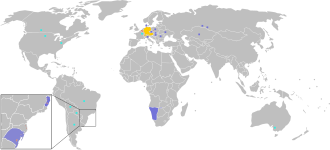ਜਰਮਨ ਭਾਸ਼ਾ
| ਜਰਮਨ | |
|---|---|
| [Deutsch, deutsche Sprache] Error: {Lang}: text has italic markup (help) | |
| ਉਚਾਰਨ | [ˈdɔʏtʃ] |
| ਜੱਦੀ ਬੁਲਾਰੇ | Primarily in German-speaking Europe, as a minority/cultural language worldwide |
Native speakers | 90 ਮੀਲੀਅਨ (2010)[1] to 95 ਮੀਲੀਅਨ (2014)[2] L2 speakers: 10–15 million (2014)[2][3] as a foreign language: 75–100 million[2] |
ਇੰਡੋ-ਯੂਰਪੀ
| |
ਮਿਆਰੀ ਰੂਪ |
|
ਲਿਖਤੀ ਪ੍ਰਬੰਧ | ਲਾਤੀਨੀ (ਜਰਮਨ ਲਿਪੀ) ਹਿਬਰੂ (ਸਿਰਫ਼ ਯਦੀਸ਼) ਜਰਮਨ ਬਰੇਲ |
Signed forms | Signed German, LBG (Lautsprachbegleitende / Lautbegleitende Gebärden) |
| ਅਧਿਕਾਰਤ ਸਥਿਤੀ | |
ਵਿੱਚ ਸਰਕਾਰੀ ਭਾਸ਼ਾ | 6 countries
3 dependencies
Several international institutions |
ਮਾਨਤਾ-ਪ੍ਰਾਪਤ ਘੱਟ-ਗਿਣਤੀ ਵਾਲੀ ਬੋਲੀ | 13 countries(minority/cultural/national language)
|
| ਰੈਗੂਲੇਟਰ | No official regulation (German orthography regulated by the Council for German Orthography[4]). |
| ਭਾਸ਼ਾ ਦਾ ਕੋਡ | |
| ਆਈ.ਐਸ.ਓ 639-1 | de |
| ਆਈ.ਐਸ.ਓ 639-2 | ger (B) deu (T) |
| ਆਈ.ਐਸ.ਓ 639-3 | Variously:deu – Germangmh – Middle High Germangoh – Old High Germangct – Alemán Colonierobar – Austro-Bavariancim – Cimbriangeh – Hutterite Germanksh – Kölschnds – Low German[lower-alpha 1]sli – Lower Silesianltz – Luxembourgish[lower-alpha 2]vmf – Main-Franconianmhn – Móchenopfl – Palatinate Germanpdc – Pennsylvania Germanpdt – Plautdietsch[lower-alpha 3]swg – Swabian Germangsw – Swiss Germanuln – Unserdeutschsxu – Upper Saxonwae – Walser Germanwep – Westphalianhrx – Riograndenser Hunsrückischyec – Yenishyid – Yiddish[lower-alpha 4] |
| Glottolog | high1287 High Franconianuppe1397 Upper German |
| ਭਾਸ਼ਾਈਗੋਲਾ | |
  | |
ਜਰਮਨ (![]() Deutsch (ਮਦਦ·ਫ਼ਾਈਲ) ਡੋਇਚ) ਗਿਣਤੀ ਦੇ ਅਨੁਸਾਰ ਯੂਰਪ ਦੀ (ਰੂਸੀ ਨੂੰ ਛੱਡ ਕੇ) ਸਭ ਵਲੋਂ ਜਿਆਦਾ ਬੋਲੀ ਜਾਣ ਵਾਲੀ ਭਾਸ਼ਾ ਹੈ। ਇਹ ਜਰਮਨੀ, ਸਵਿਟਜਰਲੈਂਡ ਅਤੇ ਆਸਟਰੀਆ ਦੀ ਮੁੱਖ ਅਤੇ ਰਾਜਭਾਸ਼ਾ ਹੈ। ਇਹ ਰੋਮਨ ਲਿਪੀ ਵਿੱਚ (ਕੁਝ ਹੋਰ ਵਾਧੂ ਚਿੰਨਾਂ ਨਾਲ) ਲਿਖੀ ਜਾਂਦੀ ਹੈ। ਇਹ ਹਿੰਦ-ਯੂਰੋਪੀ ਬੋਲੀ- ਪਰਵਾਰ ਵਿੱਚ ਜਰਮਨਿਕ ਸ਼ਾਖਾ ਵਿੱਚ ਆਉਂਦੀ ਹੈ। ਅੰਗਰੇਜ਼ੀ ਨਾਲ ਇਸਦਾ ਕਰੀਬੀ ਰਿਸ਼ਤਾ ਹੈ। ਲੇਕਿਨ ਰੋਮਨ ਲਿਪੀ ਦੇ ਅੱਖਰਾਂ ਦਾ ਇਸ ਦੀਆਂ ਧੁਨੀਆਂ ਦੇ ਨਾਲ ਮੇਲ ਅੰਗਰੇਜ਼ੀ ਦੇ ਮੁਕ਼ਾਬਲੇ ਕਿਤੇ ਬਿਹਤਰ ਹੈ। ਆਧੁਨਿਕ ਮਾਨਕੀਕ੍ਰਿਤ ਜਰਮਨ ਨੂੰ ਉੱਚ ਜਰਮਨ ਕਹਿੰਦੇ ਹਨ।
ਜਰਮਨ ਭਾਸ਼ਾ ਭਾਰੋਪੀ ਪਰਵਾਰ ਦੇ ਜਰਮੇਨਿਕ ਵਰਗ ਦੀ ਭਾਸ਼ਾ, ਆਮ ਤੌਰ 'ਤੇ ਉੱਚ ਜਰਮਨ ਦਾ ਉਹ ਰੂਪ ਹੈ ਜੋ ਜਰਮਨੀ ਵਿੱਚ ਸਰਕਾਰੀ, ਸਿੱਖਿਆ, ਪ੍ਰੈਸ ਆਦਿ ਦਾ ਮਾਧਿਅਮ ਹੈ। ਇਹ ਆਸਟਰੀਆ ਵਿੱਚ ਵੀ ਬੋਲੀ ਜਾਂਦੀ ਹੈ। ਇਸਦਾ ਉਚਾਰਣ 1898 ਈ. ਦੇ ਇੱਕ ਕਮਿਸ਼ਨ ਦੁਆਰਾ ਨਿਸ਼ਚਿਤ ਹੈ। ਲਿਪੀ ਫਰਾਂਸੀਸੀ ਅਤੇ ਅੰਗਰੇਜ਼ੀ ਨਾਲ ਮਿਲਦੀ ਜੁਲਦੀ ਹੈ। ਰਤਮਾਨ ਜਰਮਨ ਦੇ ਸ਼ਬਦ ਦੇ ਸ਼ੁਰੂ ਵਿੱਚ ਅਘਾਤ ਹੋਣ ਉੱਤੇ ਕਾਕਲਿਅ ਸਪਰਸ਼ ਹਨ। ਤਾਨ (ਟੋਨ) ਅੰਗਰੇਜ਼ੀ ਵਰਗੀ ਹੈ। ਉਚਾਰਣ ਜਿਆਦਾ ਬਲਸ਼ਾਲੀ ਅਤੇ ਸ਼ਬਦਕਰਮ ਜਿਆਦਾ ਨਿਸ਼ਚਿਤ ਹੈ। ਦਾਰਸ਼ਨਕ ਅਤੇ ਵਿਗਿਆਨਕ ਸ਼ਬਦਾਵਲੀ ਨਾਲ ਪਰਿਪੂਰਣ ਹੈ। ਸ਼ਬਦਰਾਸ਼ੀ ਅਨੇਕ ਸਰੋਤਾਂ ਤੋਂ ਲਈ ਗਈ ਹੈ।
Deutsch (ਮਦਦ·ਫ਼ਾਈਲ) ਡੋਇਚ) ਗਿਣਤੀ ਦੇ ਅਨੁਸਾਰ ਯੂਰਪ ਦੀ (ਰੂਸੀ ਨੂੰ ਛੱਡ ਕੇ) ਸਭ ਵਲੋਂ ਜਿਆਦਾ ਬੋਲੀ ਜਾਣ ਵਾਲੀ ਭਾਸ਼ਾ ਹੈ। ਇਹ ਜਰਮਨੀ, ਸਵਿਟਜਰਲੈਂਡ ਅਤੇ ਆਸਟਰੀਆ ਦੀ ਮੁੱਖ ਅਤੇ ਰਾਜਭਾਸ਼ਾ ਹੈ। ਇਹ ਰੋਮਨ ਲਿਪੀ ਵਿੱਚ (ਕੁਝ ਹੋਰ ਵਾਧੂ ਚਿੰਨਾਂ ਨਾਲ) ਲਿਖੀ ਜਾਂਦੀ ਹੈ। ਇਹ ਹਿੰਦ-ਯੂਰੋਪੀ ਬੋਲੀ- ਪਰਵਾਰ ਵਿੱਚ ਜਰਮਨਿਕ ਸ਼ਾਖਾ ਵਿੱਚ ਆਉਂਦੀ ਹੈ। ਅੰਗਰੇਜ਼ੀ ਨਾਲ ਇਸਦਾ ਕਰੀਬੀ ਰਿਸ਼ਤਾ ਹੈ। ਲੇਕਿਨ ਰੋਮਨ ਲਿਪੀ ਦੇ ਅੱਖਰਾਂ ਦਾ ਇਸ ਦੀਆਂ ਧੁਨੀਆਂ ਦੇ ਨਾਲ ਮੇਲ ਅੰਗਰੇਜ਼ੀ ਦੇ ਮੁਕ਼ਾਬਲੇ ਕਿਤੇ ਬਿਹਤਰ ਹੈ। ਆਧੁਨਿਕ ਮਾਨਕੀਕ੍ਰਿਤ ਜਰਮਨ ਨੂੰ ਉੱਚ ਜਰਮਨ ਕਹਿੰਦੇ ਹਨ।
ਜਰਮਨ ਭਾਸ਼ਾ ਭਾਰੋਪੀ ਪਰਵਾਰ ਦੇ ਜਰਮੇਨਿਕ ਵਰਗ ਦੀ ਭਾਸ਼ਾ, ਆਮ ਤੌਰ 'ਤੇ ਉੱਚ ਜਰਮਨ ਦਾ ਉਹ ਰੂਪ ਹੈ ਜੋ ਜਰਮਨੀ ਵਿੱਚ ਸਰਕਾਰੀ, ਸਿੱਖਿਆ, ਪ੍ਰੈਸ ਆਦਿ ਦਾ ਮਾਧਿਅਮ ਹੈ। ਇਹ ਆਸਟਰੀਆ ਵਿੱਚ ਵੀ ਬੋਲੀ ਜਾਂਦੀ ਹੈ। ਇਸਦਾ ਉਚਾਰਣ 1898 ਈ. ਦੇ ਇੱਕ ਕਮਿਸ਼ਨ ਦੁਆਰਾ ਨਿਸ਼ਚਿਤ ਹੈ। ਲਿਪੀ ਫਰਾਂਸੀਸੀ ਅਤੇ ਅੰਗਰੇਜ਼ੀ ਨਾਲ ਮਿਲਦੀ ਜੁਲਦੀ ਹੈ। ਰਤਮਾਨ ਜਰਮਨ ਦੇ ਸ਼ਬਦ ਦੇ ਸ਼ੁਰੂ ਵਿੱਚ ਅਘਾਤ ਹੋਣ ਉੱਤੇ ਕਾਕਲਿਅ ਸਪਰਸ਼ ਹਨ। ਤਾਨ (ਟੋਨ) ਅੰਗਰੇਜ਼ੀ ਵਰਗੀ ਹੈ। ਉਚਾਰਣ ਜਿਆਦਾ ਬਲਸ਼ਾਲੀ ਅਤੇ ਸ਼ਬਦਕਰਮ ਜਿਆਦਾ ਨਿਸ਼ਚਿਤ ਹੈ। ਦਾਰਸ਼ਨਕ ਅਤੇ ਵਿਗਿਆਨਕ ਸ਼ਬਦਾਵਲੀ ਨਾਲ ਪਰਿਪੂਰਣ ਹੈ। ਸ਼ਬਦਰਾਸ਼ੀ ਅਨੇਕ ਸਰੋਤਾਂ ਤੋਂ ਲਈ ਗਈ ਹੈ।
ਉੱਚ ਜਰਮਨ, ਕੇਂਦਰ, ਉੱਤਰ ਅਤੇ ਦੱਖਣ ਵਿੱਚ ਬੋਲੀ ਜਾਣ ਵਾਲੀ ਆਪਣੀ ਪੱਛਮੀ ਸ਼ਾਖਾ (ਲਓ ਜਰਮਨ - ਫਰਿਜਿਅਨ, ਅੰਗਰੇਜ਼ੀ) ਤੋਂ ਲਗਭਗ ਛੇਵੀਂ ਸ਼ਤਾਬਦੀ ਵਿੱਚ ਵੱਖ ਹੋਣ ਲੱਗੀ ਸੀ। ਭਾਸ਼ਾ ਦੀ ਦ੍ਰਿਸ਼ਟੀ ਤੋਂ ਪ੍ਰਾਚੀਨ ਹਾਈ ਜਰਮਨ (750-1050), ਕੇਂਦਰੀ ਹਾਈ ਜਰਮਨ (1350 ਈ . ਤੱਕ), ਆਧੁਨਿ ਹਾਈ ਜਰਮਨ (1200 ਈ . ਦੇ ਆਸਪਾਸ ਤੋਂ ਹੁਣ ਤੱਕ) ਤਿੰਨ ਵਿਕਾਸ ਪੜਾਅ ਹਨ। ਉੱਚ ਜਰਮਨ ਦੀ ਪ੍ਰਮੁੱਖ ਬੋਲੀਆਂ ਵਿੱਚ ਯਿਡਿਸ਼, ਸ਼ਵਿਜਟੁਂਸ਼, ਆਧੁਨਿਕ ਪ੍ਰਸ਼ਨ ਸਵਿਸ ਜਾਂ ਉੱਚ ਅਲੇਮੈਨਿਕ, ਫਰੰਕੋਨਿਅਨ (ਪੂਰਵੀ ਅਤੇ ਦੱਖਣੀ), ਟਿਪ੍ਰਅਰੀਅਨ ਅਤੇ ਸਾਇਲੇਸੀਅਨ ਆਦਿ ਹਨ।
ਨੋਟ
- ↑ The status of Low German as a German variety or separate language is subject to discussion.[5]
- ↑ The status of Luxembourgish as a German variety or separate language is subject to discussion.[2]
- ↑ The status of Plautdietsch as a German variety or separate language is subject to discussion.[5]
- ↑ The status of Yiddish as a German variety or separate language is subject to discussion.[6]
ਹਵਾਲੇ
- ↑ Mikael Parkvall, "Världens 100 största språk 2010" (The World's 100 Largest Languages in 2010), in Nationalencyklopedin
- ↑ 2.0 2.1 2.2 2.3 Ammon, Ulrich (November 2014). "Die Stellung der deutschen Sprache in der Welt" (PDF) (in German) (1st ed.). Berlin, Germany: de Gruyter. ISBN 978-3-11-019298-8. Retrieved 2015-07-24.
{cite web}: CS1 maint: unrecognized language (link) - ↑ Cite warning:
<ref>tag with nameeurobarometercannot be previewed because it is defined outside the current section or not defined at all. - ↑ "Rat für deutsche Rechtschreibung – Über den Rat". Rechtschreibrat.ids-mannheim.de. Retrieved 11 October 2010.
- ↑ 5.0 5.1 Cite warning:
<ref>tag with nameGoossens2000cannot be previewed because it is defined outside the current section or not defined at all. - ↑ Cite warning:
<ref>tag with nameNYT Yiddishcannot be previewed because it is defined outside the current section or not defined at all.